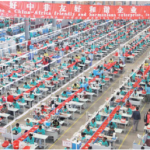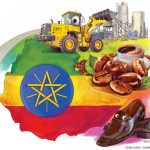 Textile companies and retailers are setting up operations in and around Addis Ababa to take advantage of the low cost of labour.
Textile companies and retailers are setting up operations in and around Addis Ababa to take advantage of the low cost of labour.
At the Bole Lemi Industrial Zone, 15km east of Addis Ababa, Taiwanese footwear manufacturer George Shoe Corporation is preparing to begin production.
In mid-April, hundreds of eager new recruits – many of them university graduates – were preparing to begin work, making up to 1,500 pairs of shoes a day.
Like its Chinese competitor Huajian – which plans to create a light manufacturing zone on the outskirts of the capital by 2023, providing employment for around 100,000 people – George has big ambitions for its Ethiopian enterprise.
In just a few years time, the company plans to open its own industrial park in Modjo, one of the country’s main tannery districts, directly employing 10,000 workers.
Leather, textile zones
Bole Lemi is one of two indus- trial zones (IZs) being established in Addis Ababa – the second is Kilinto, situated in the capital’s southern suburbs – and the government has plans to construct similar complexes in other cities, starting with Dire Dawa, Kombolcha and Awassa.
These IZs are a key feature of the ruling Ethiopian People’s Revolutionary Democratic Front’s development strategy.
The idea is to provide the space and infrastructure needed for light manufacturing to thrive. “We are going to open zones in leather and tex- tiles, but also agroprocessing,” says Sisay Gemechu, the state minister for industry.
Ethiopia slipped 37 places – from 104 in 2007 to 141 in 2012 – in the World Bank Trade Logistics Index
However, only two of Bole Lemi’s 20 factories are occupied, both by George. Sisay says that all of the completed units are rented and that it is confident the 10 further facilities being constructed will be too.
Bole Lemi seems to be a perfect metaphor for the current Ethiopian manfacturing sector: enormous potential that is as yet unfulfilled.
United Kingdom-based leather goods manufacturer Pittards is steadily expanding production in Ethiopia, as is Turkish-owned Ayka Textile.
Retailers H&M and Tesco are sponsoring training for textile workers with the aim of sourcing garments from the country. Despite this, foreign direct investment (FDI) remains low, reaching $1bn in the 2012/2013 fiscal year.
One Western economist blames the modest level of FDI on “the heavy hand of the Ethiopian government in the private sector”.
A 2012 World Bank study on Chinese FDI in Ethiopia found that 54% and 84% of investors, respectively, cited tax administration and customs and trade regulations as major constraints on their businesses.
An underdeveloped financial sector and a dysfunctional foreign exchange market are other impediments, says Jan Mikkelsen, the International Monetary Fund representative in Ethiopia.
Trading hurdles
Trade logistics in this landlocked country are also problematic.
According to the World Bank, Ethiopia has dropped from 104th to 141th place in its rankings during the past five years.
The majority of Ethiopia’s imports and exports are trucked to and from the port of Djibouti along a treacherous highway and the cost is phenomenal. A new rail link to Djibouti, scheduled for completion at the end of 2015, will reduce costs.
Even with these considerable constraints, Helen Hai, former vice-president of Huajian, argues that Ethiopia will be able to exploit its major comparative advantage – a competitive and young workforce.
“The labour cost in shoemaking in China is about 22% of the overall cost portfolio,” she explains. “In China today, the cost of each labourer is $500 [a month]. In Ethiopia it is only $50. So, the question, comes down to the efficiency.”
She claims that after one year of on-the-job training, her Ethiopian employees were able to achieve 70% of the efficiency of Chinese workers, meaning that other investors could soon follow. ●
Source The African Report




























Join Conversations